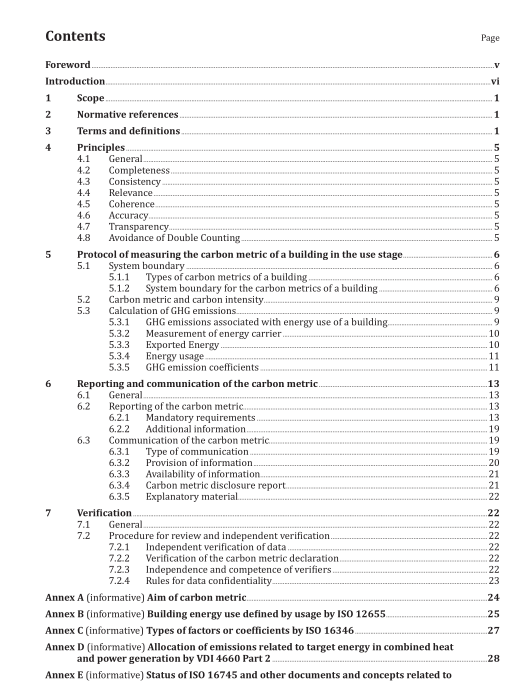BS ISO 16745:2015 pdf download.Environmental performance of buildings — Carbon metric of a building — Use stage
This International Standard provides requirements for determining and reporting a carbon metric of an existing building, associated with the operation of the building. It sets out methods for the calculation,reporting, communication, and verification of a set of carbon metrics for GHG emissions arising from the measured energy use during the operation of an existing building, the measured user-related energy use, and other relevant GHG emissions and removals. These carbon metrics are separated into three measures designated CM1, CM2, and CM3 (see 5.1.1).
This International Standard follows the principles set out in ISO 15392 and those described in Clause 4.
Where deviations from the principles in ISO 15392 occur, or where more specific principles are stated,this International Standard takes precedence.
The carbon metrics CM1 and CM2 are not quantified based on life cycle assessment (LCA) methodology.
Carbon metric CM3 may include partial quantification based on the results of LCA.
This International Standard does not include any method of modelling of the operational energy use of the building but follows the conventions provided by other International Standards, as given in relevant clauses.
This International Standard is not an assessment method for evaluating the overall environmental performance of a building or a building-rating tool and does not include value-based interpretation of the carbon metric(s) through weightings or benchmarking.
This International Standard deals with the application of the carbon metric(s) for an existing building,either residential or commercial, or a building complex. It does not include provisions for regional and/or national building stock.
2 Normative references
The following documents, in whole or in part, are normatively referenced in this document and are indispensable for its application. For dated references, only the edition cited applies. For undated references, the latest edition of the referenced document (including any amendments) applies.
ISO 6707-1:2014, Buildings and civil engineering works — Vocabulary — Part 1: General terms
ISO 12655, Energy performance of buildings — Presentation of measured energy use of buildings
ISO 14050, Environmental management — Vocabulary
ISO 15392, Sustainability in building construction — General principles
ISO/TR 16344:2012, Energy performance of buildings — Common terms, definitions and symbols for the overall energy performance rating and certification
3 Terms and definitions
For the purposes of this document, the terms and definitions given in ISO 6707-1, ISO 12655, ISO 14050,ISO 15392, ISO/TR 16344, and the following apply. Where differences or conflicts occur, the definitions given below shall take precedence.
NOTE A number of terms and definitions from these other sources have been repeated below, for ease of reference.
3.1 building services
services provided by technical building systems (3.19) and by appliances (ISO 6707-1:2014, 5.4.7) to provide indoor climate conditions, domestic hot water, illumination levels, and other services related to the use of the building (ISO 6707-1:2014, 3.1.3)
[SOURCE: ISO/TR 16344:2012, 2.1.10]
3.2 carbon intensity
carbon metric (3.3) expressed in relation to a specific reference unit related to the function (ISO 15686-10:2010, 3.10) of the building (ISO 6707-1:2014, 3.1.3)
Note 1 to entry: Examples of reference units may include per unit area, per person, per kilobyte, per unit output, and per GDP.
3.3 carbon metric
sum of annual greenhouse gas emissions (ISO 14064-1:2006, 2.5) and removals (ISO 14064-1:2006,2.6), expressed as CO 2 equivalents (ISO 14064-1:2006, 2.19), associated with the use stage of a building (ISO 6707-1:2014, 3.1.3)
3.4 cooling
removal of latent and/or sensible heat
[SOURCE: ISO 16818:2008, 3.47]
3.5 delivered energy
energy (3.6), expressed per energy carrier (3.7), supplied to the technical building systems (3.19) through the system boundary (3.18), to satisfy the uses taken into account [heating, cooling (3.4), ventilation (3.20), domestic hot water, lighting, appliances (ISO 6707-1:2014, 5.4.7), etc.], or to produce electricity Note 1 to entry: Delivered energy can be calculated for defined energy uses or it can be measured.
[SOURCE: ISO/TR 16344:2012, 2.1.33, modified by deleting the Note 1 related to active solar and wind energy systems.]
3.6 energy
capacity for doing work; having several forms that may be transformed from one to another, such as thermal (heat), mechanical (work), electrical, or chemical
[SOURCE: ISO 16818:2008, 3.74]
3.7 energy carrier
substance or phenomenon that can be used to produce mechanical work or heat (ISO 16818:2008, 3.117) or to operate chemical or physical processes
Note 1 to entry: The energy content (ISO 13602-2:2006, 3.1) of fuels (3.10) is given by their gross calorific value (ISO/TR 16344:2012, 2.1.78).
[SOURCE: ISO/TR 16344:2012, 2.1.46]
3.8 energy source
source from which useful energy (3.6) can be extracted or recovered either directly or by means of a conversion or transformation process
Note 1 to entry: Examples include oil or gas fields, coal mines, sun, forests, etc.BS ISO 16745 pdf download.BS ISO 16745 pdf download
